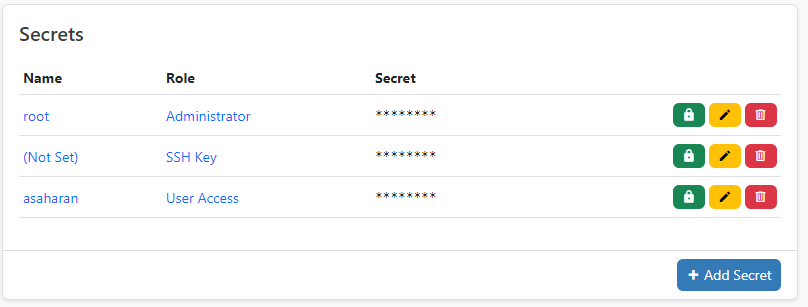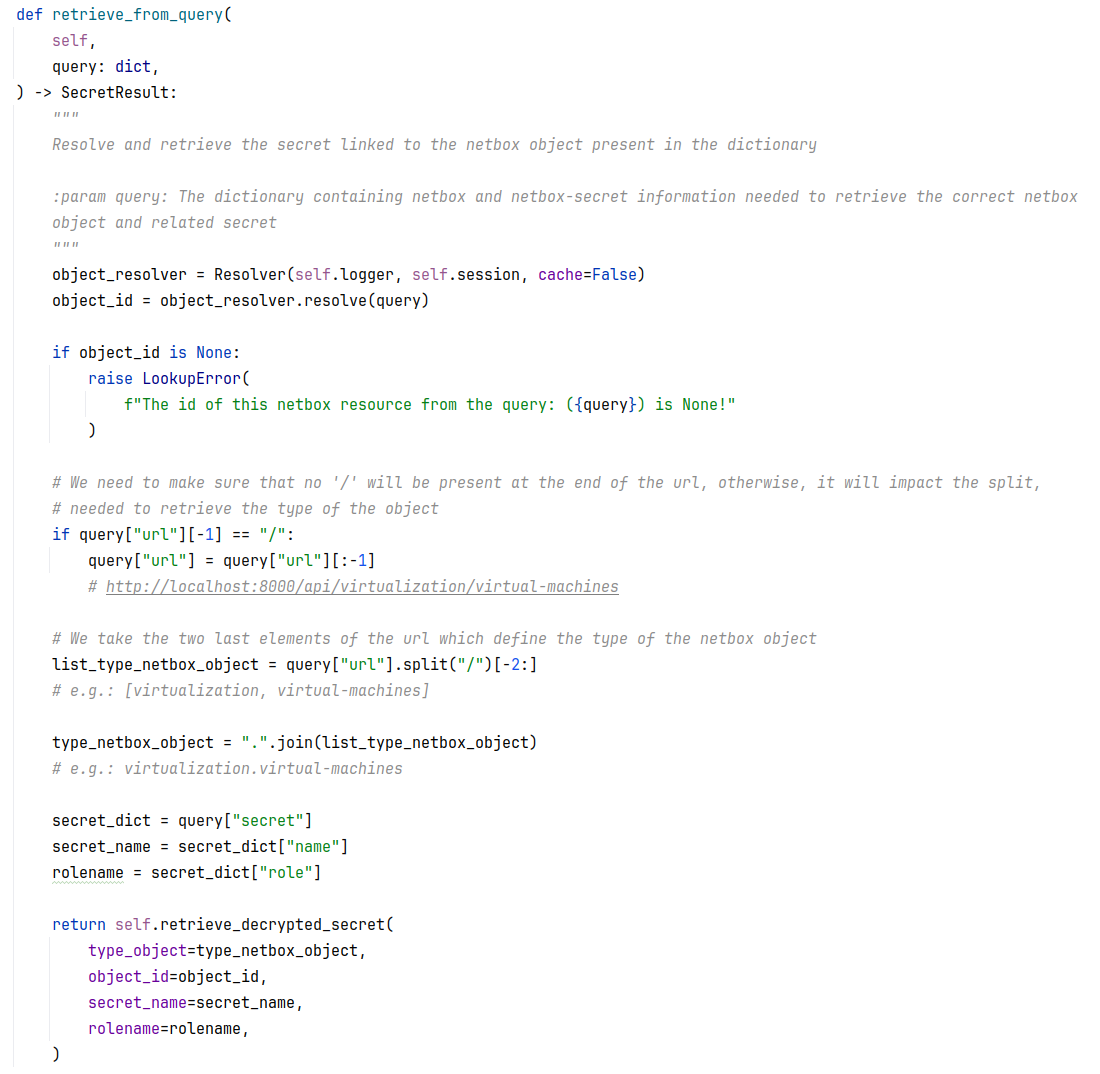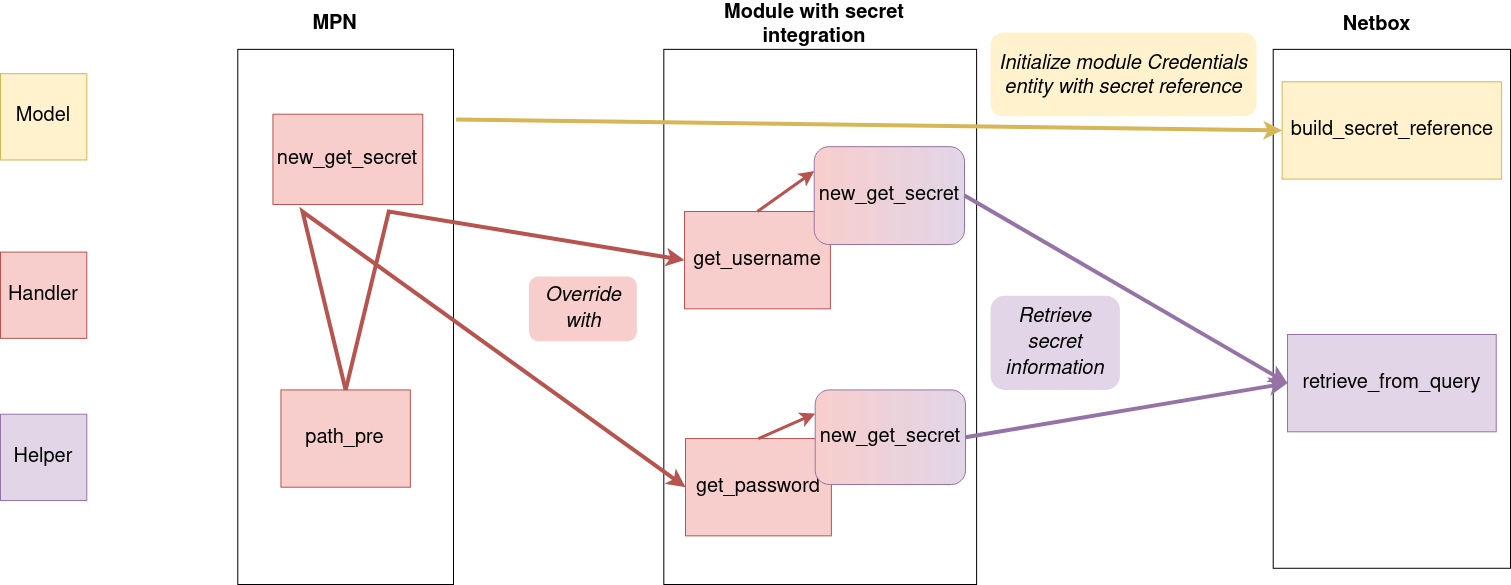Netbox-Secret¶
What is a Secret in Netbox¶
In Netbox, a secret means important information that needs to be stored securely. Furthermore, each secret can have a name parameter, which is sometimes used to store a username that is not encrypted.

A secret is always attached to a Device or a Virtual-Machine.

Role in Netbox-Secret¶
A role is always assigned to a secret, the role is usually used to describe what it is used for. For example it can be used for Login credentials or SSH keys or even for some Routing secrets.
Interaction with Netbox-Secret¶
A helper NetboxSecret and several plugins have been developed to interact with Netbox-Secret.
The helper is capable of:
Managing roles and secret
Handling the session towards Netbox-Secret
Here is the list of the plugins and their functionality:
generate_password: Retrieve or generate a password for the Netbox resource (either a VM or a Device)create_secret_role: This plugin creates a new secret rolebuild_secret_reference: Generate from the netbox resource, the query needed to retrieve the netbox object
This query can be used with the Netbox-Secret helper to retrieve the information about the specified secret.
Dealing with secrets in the Resource and the Handler¶
We will first explain what is the abstract interface that handlers should implement in order to support a secret integration. Then, we will see what is happening when the resources are exported and when the handler is trying to retrieve credentials.
Basic abstraction¶
For the secret integration, it was decided to override methods instead of fields. Why? Because each module may have a different name convention for the variable. Furthermore, the meaning of the Credential values is also not consistent, some value might expect and environment variable, other will rely on the raw value. Therefore, it’s not possible to have a generic approach with these different names. Besides it’s not desirable to have breaking changes in these modules, just to have some consistency across the modules.
The other solution was to override methods. As opposed to variables, methods can be easily refactored without having any impact for the customer (no breaking changes). So, a convention was decided to share abstract common methods: usually a handler, would need to retrieve some credentials (username/password), it would now retrieve these credentials from methods respecting the following abstraction.
def some_meaninful_method_name(self, ctx: handler.HandlerContext, resource: Resource) -> str:
pass
Each handler wanting to interact with the secret integration has been updated to follow this convention. In MPN, usually with
a get_username and a get_password methods but the name of the methods does not need to be consistent across modules.
Resource - Export phase¶
In MPN, we override the ResourceHandler.pre method to check if a secret_reference field exists in the resource.
If it is the case, we check which method needs to be overriden by the secret:
Two methods can be overriden:
The one contained in the
method_to_override_secretvariable, usually the passwordThe one contained in the
method_to_override_name_secretvariable, usually the username. This override is optional, so if nothing is set in the entry, this override will be skipped.
Handler - Retrieval phase¶
The new methods will retrieve the secret from Netbox-Secret, to do so, the agent will need to have the RSA key pair. Depending on the information that needs to be retrieved, the handler will get the secret’s name or the secret plaintext.
Retrieval of secrets¶
If a resource intends to rely on Netbox-Secret, it needs to possess a secret_reference field to make aware the handler
that an integration with secret is possible. Furthermore, only the resource “knows” which Netbox resource the
Netbox-Secret helper would need to resolve the secret. Therefore, the responsibility for the secret integration is given
to the resource that needs it.
The field will contain the query that we mentioned earlier. This query contains two parts:
The part to resolve the Netbox resource (vertical yellow line on the left)
The part to resolve the secret linked to this Netbox Resource (vertical gray line on the left)

We will explain in the next sections how to resolve and retrieve these different information.
Resolve a Netbox resource¶
The Netbox object will be resolved by this class:

We use two pieces of information to resolve Netbox objects:
The URL to retrieve the Netbox object
A query containing information used to identity the Netbox Object
A query can contain sub-query, e.g. if a Netbox object depends on the resolution of another Netbox object
In the previous example, we have a direct reference because the query contains a string that represents the name of the object we want to find.
How do we identify a secret¶
Given that we cannot rely on the secret’s name, we must adapt the search depending on the provided input. Two parameters are always used during the search: a Netbox resource (where the secret is / will be stored) and the role of the secret.

We mainly handle two cases:
Either the secret’s name is provided, then we rely also on the name of the secret. For example, if a Netbox resource possesses multiple secrets with the same role, the name is used to distinguish them.
In the other case, we only rely on the two mandatory information: the Netbox resource and the role of the secret
Global overview¶
Here is a global overview on how this secret integration works with Netbox:

Initial setup¶
This helper assumes that an RSA key pair will be already linked to Netbox-Secret. Unless explicitly requested, the helper does not support any operation tampering with the remote public key.
This feature is not supported mainly for two reasons:
We should not manage such sensitive information
There is an active issue in the Netbox-Secret plugin, see https://github.com/Onemind-Services-LLC/netbox-secrets/issues/89. This issue implies that we must rely on an HTML session instead of using the Rest API.
General information¶
If a netbox object storing a secret is deleted, the secret will not be deleted. The secret will be completely broken given that its dependency does not exist anymore. The only possible operation is to remove the problematic secret.
Rotating keys¶
If the last RSA key pair were to be changed, some precautions should be taken in order to avoid ending with a broken netbox instance.
Any existing session keys should be removed
Every secret created with this setup should be deleted